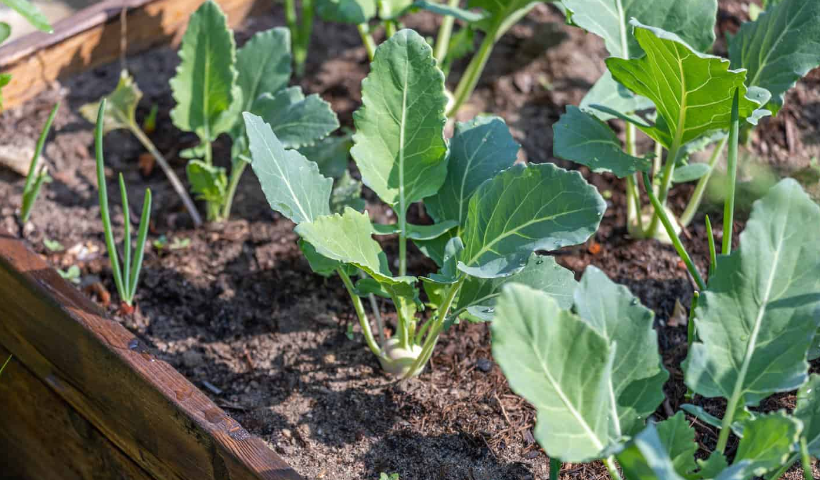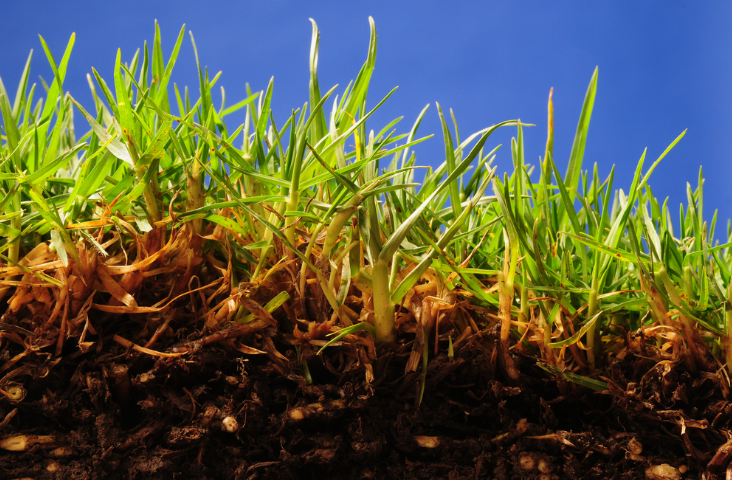7 Reasons Why Your Kohlrabi Isn’t Forming a Bulb

If you have ever attempted growing kohlrabi, then you probably know it can be challenging and time consuming to care for. Kohlrabi plants require up a lot of space while only yielding one golf-ball-sized bulb at maturity. You also have to face growing kohlrabi problems like:
- Why won’t my kohlrabi bulb?
- Will kohlrabi grow without leaves?
- Why is my kohlrabi not forming bulbs?
So, let’s talk about how you can solve your Kohlrabi plants problems!
Kohlrabi plants that experience stress won’t produce bulbs. Plant spacing is usually the cause, with seedlings needing to be placed 10 inches apart for proper growth. Environmental stresses like heat or drought, insufficient daylight hours, soil deficiencies, weeds or certain pests all have the ability to hinder bulb formation in kohlrabi.
7 Reasons For Kohlrabi Not Forming Bulb
Here are 7 main causes why your kohlrabi crop might experience stunted growth and kohlrabi not forming bulb:
1. Improper spacing
Kohlrabi seedlings need to be spaced 9 to 12 inches apart for the fully mature plant to have room to thrive. If you direct sow your kohlrabi plants, make sure to thin them to about 10 inches in every direction. Planting module-grown kohlrabi seedlings is much easier, as you can plant them in their final locations without spending time on tedious thinning.
I’ve planted kohlrabi plants 6 inches apart when I tried to do intensive gardening and spaced most of my crops very close together. Some kohlrabi plants did develop nicely, but about half of them suffered and didn’t bulb, so definitely have this plant competition in mind before placing your seedlings in the ground.
2. Too much or too little water
I don’t like to water the garden that often and I rely on mulches and rainfall to do the work for me. However, while too much water will lead to kohlrabi stems cracking, drought will definitely have an impact on bulb size.
I experienced this when planting kohlrabi as fall crops in August and not watering them nearly enough. It was a dry autumn, and I ended up with some leaves and just a couple of bulbs.
In the seedling stage, most of us tend to coddle our plants, water them often, and then kind of forget about them. Kohlrabi differs from root vegetables in that it requires consistent water supply throughout its development process.
Like cabbage, kohlrabi needs 1 1/2 inches of rain or water each week – either through rainfall or irrigation – in order to stay healthy and productive. When watering during dry spells, make sure it occurs first thing in the morning to allow its leaves to dry out during the daytime hours.
Remember to do this regularly, as an even water supply guarantees those juicy kohlrabi bulbs.
3. High temperatures
Kohlrabi is a cool-weather crop. It does best when planted early in spring or as a fall crop, right after the summer weather is starting to cool off. One thing is for sure, kohlrabi plants absolutely hate hot weather, and anything above 80°F (27°C) will stunt their growth.
As a gardener, it’s your job to pick the absolute best time to sow kohlrabi – and with so many microclimates, that’s no easy task. If you have short springs, the best way to start kohlrabi is undercover, either indoors under grow lights, or in a greenhouse or polytunnel. This way, you can start them early while there’s still snow on the ground, in order to avoid the heat in late June.
If you’re planting your kohlrabi as a fall crop, wait for temperatures to drop to 75°F (24°C) or lower, which is often difficult to do if you’re racing to get plants in the ground before the first frost. They survive mild frosts, so it’s best too wait, rather than plant them out too soon.
While some experts recommend mid-summer planting to get a fall harvest, I’ve never had success with this, as the extreme heat of July and mid-August always seemed to affect my kohlrabi seedlings. In fact, despite the short growing season, I’ve always had more luck with kohlrabi spring sowings.
4. Not enough light / day length
Kohlrabi plants don’t do well in shade. In fact, spacing is so important because even shading each other if planted too closely together can lead to smaller bulbs.
Plant your kohlrabi seedlings in a bed that will receive at least 6 hours of direct sunlight and won’t be shaded by taller neighboring plants as they grow.
While there’s not much data on how kohlrabi plants are affected by day length, there’s no doubt that shorter daylight intervals affect our plants’ activity. Some fall brassica crops, like cauliflower, for example, start to develop heads when days get shorter.
In my short experience, my kohlrabi did best in spring, when days were the longest, and failed to produce in autumn, but that might be for entirely different reasons, like drought. However, it’s good to keep day length in mind and observe your fall crops closely.
5. Soil deficiencies
While kohlrabi isn’t a heavy feeder, it will benefit from a top dressing of homemade compost or well-rotted manure at the beginning of the growing season.
Soil fertility will affect flavor, and a lack of certain nutrients can prevent kohlrabi from forming its bulbous stem. Phosphorous, for example, is responsible for the fruiting stage, but before fertilizing your soil with phosphorous, it’s best to get your soil tested to make sure it’s really deficient.
Potassium is another nutrient that kohlrabi reportedly thrives on, and wood ashes are a good natural source. You can sprinkle wood ashes around your kohlrabi seedlings, and this will also help protect them from slugs in the early stages.
You could also use comfrey liquid fertilizer every now and then on your kohlrabi plants. It’s a balanced feed that keeps them healthy and strong.
Aside from deficiencies, your soil could also contain an excess of nutrients. Nitrogen in excess causes luxuriant leaf growth, but little to no fruiting. A good indicator is looking at your radishes, are they producing more leaves than fruit? If that’s the case, you might want to test your soil.

6. Weeds
Like most brassicas, kohlrabi hates competition. We’ve already covered proper spacing, but you should also keep an eye on weeds and not let them get out of hand. Weeds that grow too tall or develop deep root systems undisturbed will affect your crop’s overall uniformity and yield, sometimes stunting neighboring kohlrabi plants altogether.
It’s best to catch those pesky weeds at an early stage and remove them by hand or disturb their young root systems with a garden hoe. Generous spacing will prove to be handy since you’ll be getting your gardening tools in between the plants.
7. Pest attacks
Kohlrabi is prone to attacks from three main garden pests: slugs, flea beetles, and cabbage worms. While these pests aren’t directly responsible for kohlrabi not growing bulb, they can seriously stress the plants and affect their growth.
I’ve dealt with them all and, while I’ve suffered some losses.
This is how I managed to keep my kohlrabi seedlings alive and well:
Kohlrabi and Slugs
Come spring, slugs wake up and resurface from their hiding places. I like to plant my kohlrabi seedlings as soon as the ground is snow-free and will allow it. But since I protect them with a warm layer of fleece, I don’t always notice what’s going on underneath. Beware hungry slugs can decimate an entire planting of kohlrabi seedlings in a matter of days.
This is what you need to know:
- If you’re gardening in raised beds, kohlrabi seedlings closest to the wooden edges will get eaten first, since that’s where slugs tend to hide;
- Sprinkling wood ashes in a circle around your seedlings will help, since slugs can’t cross it very well, unless it’s wet.
- Zeolite sprinkled as a barrier works even better. These pointy mineral fragments are sharp, and slugs hate them.
- Beer traps don’t work well, so don’t even bother.
Kohlrabi and Flea Beetles
As the weather warms up, a flea beetles invasion is imminent. These annoying tiny bugs will poke holes in anything that’s green, young, and juicy. They do have certain preferences, though, and you can leverage them to your advantage:
- Plant arugula and radishes as sacrificial crops next to your kohlrabi. Flea beetles are crazy about arugula and won’t bother with your brassica seedlings;
- Protect your crop with meshes or fleece – this is better than nothing, but unless you bury the edges and never lift them up, flea beetles can still get underneath.
Kohlrabi and cabbage worms
Kohlrabi is not immune to the cabbage moth, and towards the end of the season, especially with fall crops, you might notice multiple cabbage worms chomping on your kohlrabi leaves. This will undoubtedly affect their growth since many of these infestations happen right before kohlrabi plants start developing their bulbs.
Here’s what you can do:
- Keep your brassicas covered with mesh the entire time they’re growing;
- Spray with BT regularly to inhibit cabbage worms;
- If nothing else works, pick the worms by hand a few days in a row.
Conclusion:
A few more things to note if you’re still having trouble with kohlrabi:
- Always choose early varieties if you’re dealing with short springs.
- Purple kohlrabi tends to grow better than green kohlrabi.
- Giant kohlrabi varieties could be more efficient in terms of bulbing and production.
Some gardeners can’t grow certain crops no matter what they do. If that’s the case with you and kohlrabi, and you’ve tried everything that’s up to you…then change ZIP codes. Just kidding, there’s always something you can do to trick mother nature.
So keep looking for that kohlrabi variety that works best for you, know your climate, and coddle your plants as much as possible. Happy gardening!
Ciara Konhaus

I’m Ciara and I’m a gardener and agricultural educator in zone 6b. I’ve farmed and gardened all over the Appalachian mountains and love to empower people with the tools they need to start their own gardens.
